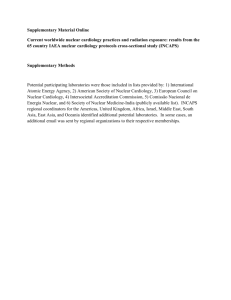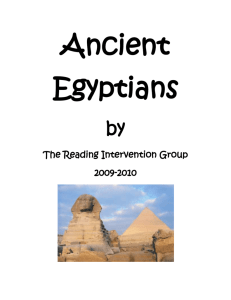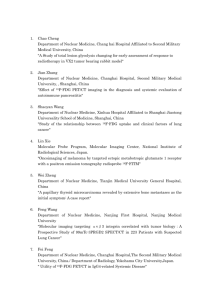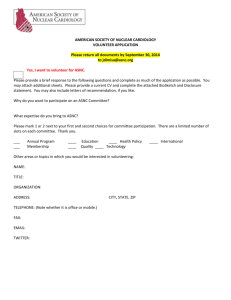International Council
advertisement
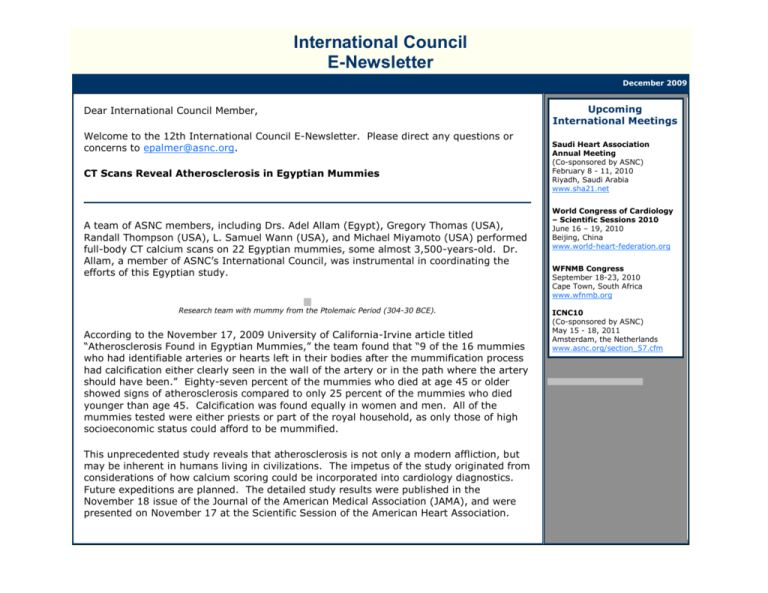
International Council E-Newsletter December 2009 Dear International Council Member, Welcome to the 12th International Council E-Newsletter. Please direct any questions or concerns to epalmer@asnc.org. CT Scans Reveal Atherosclerosis in Egyptian Mummies A team of ASNC members, including Drs. Adel Allam (Egypt), Gregory Thomas (USA), Randall Thompson (USA), L. Samuel Wann (USA), and Michael Miyamoto (USA) performed full-body CT calcium scans on 22 Egyptian mummies, some almost 3,500-years-old. Dr. Allam, a member of ASNC’s International Council, was instrumental in coordinating the efforts of this Egyptian study. Research team with mummy from the Ptolemaic Period (304-30 BCE). According to the November 17, 2009 University of California-Irvine article titled “Atherosclerosis Found in Egyptian Mummies,” the team found that “9 of the 16 mummies who had identifiable arteries or hearts left in their bodies after the mummification process had calcification either clearly seen in the wall of the artery or in the path where the artery should have been.” Eighty-seven percent of the mummies who died at age 45 or older showed signs of atherosclerosis compared to only 25 percent of the mummies who died younger than age 45. Calcification was found equally in women and men. All of the mummies tested were either priests or part of the royal household, as only those of high socioeconomic status could afford to be mummified. This unprecedented study reveals that atherosclerosis is not only a modern affliction, but may be inherent in humans living in civilizations. The impetus of the study originated from considerations of how calcium scoring could be incorporated into cardiology diagnostics. Future expeditions are planned. The detailed study results were published in the November 18 issue of the Journal of the American Medical Association (JAMA), and were presented on November 17 at the Scientific Session of the American Heart Association. Upcoming International Meetings Saudi Heart Association Annual Meeting (Co-sponsored by ASNC) February 8 - 11, 2010 Riyadh, Saudi Arabia www.sha21.net World Congress of Cardiology – Scientific Sessions 2010 June 16 – 19, 2010 Beijing, China www.world-heart-federation.org WFNMB Congress September 18-23, 2010 Cape Town, South Africa www.wfnmb.org ICNC10 (Co-sponsored by ASNC) May 15 - 18, 2011 Amsterdam, the Netherlands www.asnc.org/section_57.cfm Conference of the Nuclear Cardiological Society of India The 7th Bienneal Conference of the Nuclear Cardiological Society of India (NCSI) was held from November 13 - 15, 2009 in Mumbai, India. The event was hosted by Dr. G. N. Mahapatra, NCSI President and new International Council member. Delegates included nuclear medicine physicians and cardiologists from across the country as well as international experts. ASNC member Dr. Prem Soman (USA) delivered the Keynote Address titled "Cardiovascular Nuclear Imaging for Optimizing the Treatment of Coronary Artery Disease" on the inaugural day. The Homi Baba Oration, a session devoted to cardiac imaging, titled "Future of Cardiovascular Imaging in the Era of Multimodality Imaging" was delivered by Dr. Avijit Lahiri (United Kingdom). Other international delegates included Dr. Simona Ben-haim (United Kingdom), Dr. Carlos Cunha (Brazil), and Dr. Felix Keng (Singapore). The scientific program was coordinated by Dr. Arun Malhotra (India) and Dr. Diwakar Jain (USA). The event reflected the growth of the field of Nuclear Cardiology in India. Predictions for the Future While enjoying the cuisine at a Minneapolis, Minnesota tavern during the October 2009 ASNC Annual Scientific Sessions, a number of international nuclear cardiology experts joined together to assess the future. Pictured (left to right): Drs. Terrance Chua (Singapore), Benjamin McAllister, Jr (US), Samuel Wann (US), Cecilia Ziadi, (Canada) Angela Koh (Singapore), Scott Jerome (US), Dennis Calnon (US), Kevin Allman (Australia), Elizabeth Klodas (US), Randall Thompson (US), Dominique Delbeke (US), Delila Heunsing (US) , Jerry Blackwell (US), Robert Beanlands, (Canada), Myron Gerson (US), Michael Freeman, (Canada), Hiro Yasuda (US), Yuki Nishimura (Japan), Gregory Thomas (US). Participants commented on many new options that are now or soon to be available. Asked what they expect to be reviewing on their imaging computer screen in five years, many focused on the potential use of software to fuse anatomic images onto SPECT or PET perfusion images. The survey predictions are as follows: Current or Fast SPECT 29% SPECT-CT 24% PET 19% PET-CT 14% CT Perfusion 5% CT Coronary 5% Stress Echocardiography 5% International Council E-Newsletter December 2009 Dear International Council Member, Welcome to the 12th International Council E-Newsletter. Please direct any questions or concerns to epalmer@asnc.org. CT Scans Reveal Atherosclerosis in Egyptian Mummies A team of ASNC members, including Drs. Adel Allam (Egypt), Gregory Thomas (USA), Randall Thompson (USA), L. Samuel Wann (USA), and Michael Miyamoto (USA) performed full-body CT calcium scans on 22 Egyptian mummies, some almost 3,500-years-old. Dr. Allam, a member of ASNC’s International Council, was instrumental in coordinating the efforts of this Egyptian study. Research team with mummy from the Ptolemaic Period (304-30 BCE). According to the November 17, 2009 University of California-Irvine article titled “Atherosclerosis Found in Egyptian Mummies,” the team found that “9 of the 16 mummies who had identifiable arteries or hearts left in their bodies after the mummification process had calcification either clearly seen in the wall of the artery or in the path where the artery should have been.” Eighty-seven percent of the mummies who died at age 45 or older showed signs of atherosclerosis compared to only 25 percent of the mummies who died younger than age 45. Calcification was found equally in women and men. All of the mummies tested were either priests or part of the royal household, as only those of high socioeconomic status could afford to be mummified. This unprecedented study reveals that atherosclerosis is not only a modern affliction, but may be inherent in humans living in civilizations. The impetus of the study originated from considerations of how calcium scoring could be incorporated into cardiology diagnostics. Future expeditions are planned. The detailed study results were published in the November 18 issue of the Journal of the American Medical Association (JAMA), and were presented on November 17 at the Scientific Session of the American Heart Association. Conference of the Nuclear Cardiological Society of India The 7th Bienneal Conference of the Nuclear Cardiological Society of India (NCSI) was held from November 13 - 15, 2009 in Mumbai, India. The event was hosted by Dr. G. N. Mahapatra, NCSI President and new International Council member. Delegates included nuclear medicine physicians and cardiologists from across the country as well as international experts. ASNC member Dr. Prem Soman (USA) delivered the Keynote Address titled "Cardiovascular Nuclear Imaging for Optimizing the Treatment of Coronary Artery Disease" on the inaugural day. The Homi Baba Oration, a session devoted to cardiac imaging, titled "Future of Cardiovascular Imaging in the Era of Multimodality Imaging" was delivered by Dr. Avijit Lahiri (United Kingdom). Other international delegates included Dr. Simona Benhaim (United Kingdom), Dr. Carlos Cunha (Brazil), and Dr. Felix Keng (Singapore). The scientific program was coordinated by Dr. Arun Malhotra (India) and Dr. Diwakar Jain (USA). The event reflected the growth of the field of Nuclear Cardiology in India. Predictions for the Future While enjoying the cuisine at a Minneapolis, Minnesota tavern during the October 2009 ASNC Annual Scientific Sessions, a number of international nuclear cardiology experts joined together to assess the future. Pictured (left to right): Drs. Terrance Chua (Singapore), Benjamin McAllister, Jr (US), Samuel Wann (US), Cecilia Ziadi, (Canada) Angela Koh (Singapore), Scott Jerome (US), Dennis Calnon (US), Kevin Allman (Australia), Elizabeth Klodas (US), Randall Thompson (US), Dominique Delbeke (US), Delila Heunsing (US) , Jerry Blackwell (US), Robert Beanlands, (Canada), Myron Gerson (US), Michael Freeman, (Canada), Hiro Yasuda (US), Yuki Nishimura (Japan), Gregory Thomas (US). Participants commented on many new options that are now or soon to be available. Asked what they expect to be reviewing on their imaging computer screen in five years, many focused on the potential use of software to fuse anatomic images onto SPECT or PET perfusion images. The survey predictions are as follows: Current or Fast SPECT 29% SPECT-CT 24% PET 19% PET-CT 14% CT Perfusion 5% CT Coronary 5% Stress Echocardiography 5%
![[Medical Director] [Name of Contractor] [Address] [Address] [Date](http://s3.studylib.net/store/data/007181140_1-9fc41a11423fb81baaffea8254c27e1e-300x300.png)
